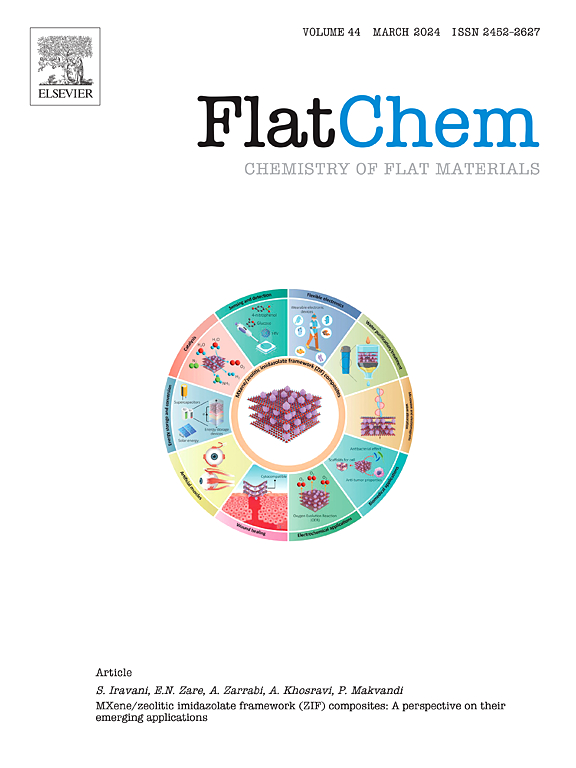Incorporation of WCe oxides on Ti3C2Tx/gC3N4 bi-layers: An efficient photocatalyst under visible/sunlight irradiation
IF 6.2
3区 材料科学
Q2 CHEMISTRY, PHYSICAL
引用次数: 0
Abstract
In this study, WO3 incorporated CeO2 on Ti3C2Tx/gC3N4 bi-layers (WCTG) were prepared using a facile hydrothermal method. The physicochemical properties of the WCTG were analyzed through various methods, including XRD, FT-IR, UV-DRS, AFM, XPS, BET, FE-SEM, HR-TEM, EDAX, and SAED. The XRD analysis indicated that WCTG exhibited a hexagonal crystal structure with a crystallite size of 39.6 nm. Additionally, the UV DRS analysis revealed that WCTG had a band gap energy of 2.79 eV, with its absorption edges confirming that all prepared ratios were situated within the visible spectrum. From the FE-SEM analysis, WCTG exhibited an agglomerated sheet-like morphology. The photocatalytic removal of Orange G (OG) under natural sunlight and visible light irradiation was effectively facilitated by Ti3C2Tx, and gC3N4-based CeO2 incorporated WO3 nanomaterial exhibited an excellent degradation performance of 99.73 % under sunlight (180 min) and 99.8 % under visible light (300 min) irradiations. COD removal percentages for 5 ppm were 96.15 % under sunlight and 95.71 % under visible light. Compared to pristine WO3 and CeO2, WCTG exhibited a 2-fold increase in degradation percentage. Various factors were discussed, such as preliminary optimization, kinetics, scavengers, and stability analysis. The results indicated that the presence of two carbon sources and a vast surface area facilitates the improved photocatalytic activities of WCTG under natural visible/sunlight for azo dye degradation.

WCe氧化物在Ti3C2Tx/gC3N4双层膜上的掺入:可见光/日光照射下的高效光催化剂
本研究采用水热法在Ti3C2Tx/gC3N4双层(WCTG)上制备了WO3掺杂CeO2。通过XRD、FT-IR、UV-DRS、AFM、XPS、BET、FE-SEM、HR-TEM、EDAX、SAED等多种方法对WCTG的理化性质进行了分析。XRD分析表明,WCTG为六方晶体结构,晶粒尺寸为39.6 nm。此外,紫外DRS分析显示WCTG的带隙能量为2.79 eV,其吸收边缘证实了所有制备的比率都位于可见光谱内。从FE-SEM分析,WCTG表现出团聚片状形貌。Ti3C2Tx有效地促进了自然光照和可见光照射下的光催化去除橙色G (OG), gc3n4基CeO2掺杂WO3纳米材料在阳光照射(180 min)和可见光照射(300 min)下的降解性能分别为99.73%和99.8%。5 ppm的COD去除率在日光下为96.15%,在可见光下为95.71%。与原始的WO3和CeO2相比,WCTG的降解率提高了2倍。讨论了各种因素,如初步优化,动力学,清除剂和稳定性分析。结果表明,两种碳源的存在和大面积的表面积有利于提高WCTG在自然可见光/日光下降解偶氮染料的光催化活性。
本文章由计算机程序翻译,如有差异,请以英文原文为准。
求助全文
约1分钟内获得全文
求助全文
来源期刊

FlatChem
Multiple-
CiteScore
8.40
自引率
6.50%
发文量
104
审稿时长
26 days
期刊介绍:
FlatChem - Chemistry of Flat Materials, a new voice in the community, publishes original and significant, cutting-edge research related to the chemistry of graphene and related 2D & layered materials. The overall aim of the journal is to combine the chemistry and applications of these materials, where the submission of communications, full papers, and concepts should contain chemistry in a materials context, which can be both experimental and/or theoretical. In addition to original research articles, FlatChem also offers reviews, minireviews, highlights and perspectives on the future of this research area with the scientific leaders in fields related to Flat Materials. Topics of interest include, but are not limited to, the following: -Design, synthesis, applications and investigation of graphene, graphene related materials and other 2D & layered materials (for example Silicene, Germanene, Phosphorene, MXenes, Boron nitride, Transition metal dichalcogenides) -Characterization of these materials using all forms of spectroscopy and microscopy techniques -Chemical modification or functionalization and dispersion of these materials, as well as interactions with other materials -Exploring the surface chemistry of these materials for applications in: Sensors or detectors in electrochemical/Lab on a Chip devices, Composite materials, Membranes, Environment technology, Catalysis for energy storage and conversion (for example fuel cells, supercapacitors, batteries, hydrogen storage), Biomedical technology (drug delivery, biosensing, bioimaging)
 求助内容:
求助内容: 应助结果提醒方式:
应助结果提醒方式:


